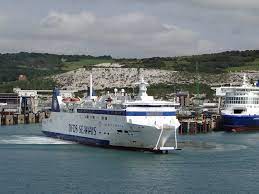Govt Confirms Guangzhou Shipyard to Build Two New Inter-Island Ferries
The procurement is being managed through Ferry Holdings Limited, a government-owned entity established to oversee the design, financing, and delivery of the new vessels.

- Country:
- New Zealand
The Government has confirmed that Guangzhou Shipyard International (GSI) will construct two new inter-island ferries for New Zealand, marking a major milestone in the country’s maritime infrastructure renewal. The announcement was made today by Rail Minister Winston Peters, who said the deal represents a “no-nonsense” and cost-effective solution to replacing the nation’s ageing Cook Strait ferry fleet.
The procurement is being managed through Ferry Holdings Limited, a government-owned entity established to oversee the design, financing, and delivery of the new vessels.
China’s Leading Shipbuilder Chosen for Key National Project
“GSI is the largest modern integrated shipbuilding enterprise in Southern China, founded in 1954 and listed on both the Hong Kong and Shanghai stock exchanges,” Peters said.
Guangzhou Shipyard International (GSI) has a long record of constructing advanced passenger and cargo vessels for international clients. It has delivered hundreds of large-scale ships globally, including ferries, container ships, LNG carriers, and naval vessels. The company’s extensive experience and global reputation were key factors in its selection.
According to the Minister, working with a builder of GSI’s competence, capability, and capacity demonstrates the Government’s commitment to achieving the best outcome for taxpayers.
“We want the best deal possible for New Zealand taxpayers, and a shipbuilder of the competence, capability and capacity of GSI underscores the high degree of confidence in our no-nonsense ferry replacement programme,” Mr Peters said.
Ferry Specifications: Bigger, Stronger, and More Efficient
The two ferries will be 200 metres long and designed to carry both rail and road vehicles, as well as up to 1,500 passengers each. The design reflects a dual-purpose focus on freight and passenger transport, ensuring efficiency across the Cook Strait route.
The ships will feature dedicated rail decks for Interislander freight wagons, road lanes for trucks and cars, and state-of-the-art safety systems. They are expected to operate on more sustainable fuel technologies, aligning with the Government’s environmental objectives and global maritime emissions standards.
“These ships will provide decades of reliable service and represent a major step forward in resilience and sustainability for New Zealand’s inter-island transport network,” an official close to the project said.
Completion and Delivery Timetable
Under the current framework, the ferries are expected to be completed by 2029, with full delivery of specifications agreed upon. The final negotiations between Ferry Holdings and GSI are still underway, covering pricing, construction timelines, and technical specifications.
While Peters declined to reveal the financial terms, he confirmed that the arrangement includes a fixed-price contract, ensuring cost certainty for taxpayers.
“Ferry Holdings and GSI are still in negotiations, and details will not be disclosed until these negotiations are completed along with the port agreements with CentrePort Limited and Port Marlborough New Zealand Limited,” he said.
Replacing Project iReX with a “No-Nonsense” Approach
The decision follows the Government’s cancellation of the previous iReX (Inter-Island Resilience Connection) project, which had ballooned in cost under the former administration. The iReX programme, led by KiwiRail, aimed to build larger hybrid-electric ferries but faced budget overruns of more than $1.5 billion and escalating port infrastructure costs.
Winston Peters has described the iReX plan as “over-engineered and fiscally irresponsible,” arguing that the Government’s return to its earlier 2020 model represents significant savings and a more pragmatic approach.
“We intend to make an announcement before the end of this year detailing our agreements and how we have saved the taxpayer billions by cancelling project iReX and returning to the no-nonsense solution we started in May 2020,” Peters said.
Port Infrastructure and National Connectivity
The upcoming announcement will also include agreements with CentrePort in Wellington and Port Marlborough in Picton, which will serve as the primary terminals for the new ferries.
These ports are expected to undergo upgrades to accommodate the larger vessels, including strengthened wharves, improved passenger terminals, and enhanced rail connectivity. The aim is to create a seamless transport corridor between the North and South Islands — one capable of handling New Zealand’s growing freight and passenger demand.
Transport and logistics experts say that the new ferries will significantly enhance supply chain resilience, reducing bottlenecks and ensuring continuity in case of disruptions to air or road freight.
Economic and Strategic Significance
The ferry replacement programme is not just a transport upgrade but a strategic infrastructure investment that underpins New Zealand’s economy. The Cook Strait route carries over 1 million passengers and 4 million tonnes of freight annually, serving as a vital link between the islands.
By contracting GSI, the Government is also seeking to benefit from competitive international pricing and proven shipbuilding expertise, something that smaller domestic shipyards could not match at the required scale.
Economic analysts have noted that the use of a fixed-price international contract shields New Zealand from potential inflationary pressures and project management risks that have affected other large infrastructure ventures.
Looking Ahead
With final contract details expected before the end of the year, the Government’s ferry replacement programme is positioned as a cornerstone of its infrastructure and transport policy.
Winston Peters emphasised that the focus remains on delivering reliable, affordable, and efficient transport for decades to come.
“This is a project grounded in practicality, fiscal responsibility, and confidence in New Zealand’s future,” Peters said. “The new ferries will connect our islands, support our economy, and serve our people for generations.”
The first ship is expected to enter service in 2029, symbolising a new era in New Zealand’s maritime connectivity.










